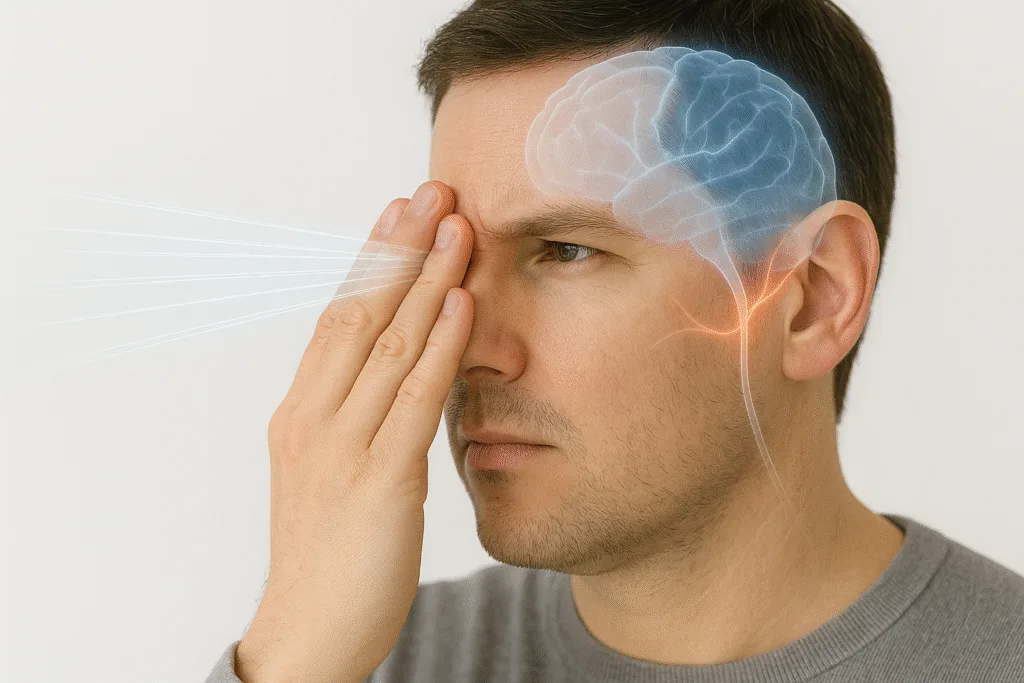Your eyes are constantly working together, but you rarely use them individually.
This simple one-eye focus test reveals how each eye behaves on its own — and it only takes 30 seconds.
Most people don’t realize:
- one eye is naturally stronger
- one eye focuses faster
- each eye sees colors slightly differently
- depth perception changes dramatically when only one eye is used
This experiment shows how sharp your vision really is, and how your brain adapts at incredible speed.
Let’s test your eyes.
Step 1 — Cover One Eye and Focus on a Small Object
Choose a small object 1 to 3 meters away:
a doorknob, a switch, a bottle, or anything with edges.
Now:
- cover your left eye gently
- keep your right eye open
- look at the object for 5–8 seconds
What you may notice
Your open eye might produce:
- a brief blur
- slight fuzziness
- color shift
- delay before sharpness
- a small jump in clarity
This shows how your brain calibrates vision when one eye works alone.
This is the first part of the one-eye focus test.
Step 2 — Switch Eyes and Repeat the Experiment
Now do the opposite:
- cover your right eye
- open the left eye
- look at the same object for 5–8 seconds
Compare the results
You may notice:
- one eye sharpens faster
- one eye sees brighter colors
- one eye has stronger contrast
- one eye feels “comfortable,” the other feels “effortful”
Your eyes are not identical — and this experiment proves it instantly.
Step 3 — Identify Your Dominant Eye
Eye dominance is similar to hand dominance.
The dominant eye:
- focuses faster
- sees sharper edges
- feels more natural
- guides your depth perception
- determines accuracy in sports
How to recognize dominance
Ask yourself:
- Which eye gave a clearer image?
- Which one focused instantly?
- Which one felt “in control”?
Whichever eye performed better during the one-eye focus test is your dominant eye.
Most people never realize this until they test it.
Step 4 — Test Your Focusing Speed (Near vs. Far)
Now, with just one eye open:
- Hold your finger 10 cm from your face
- Look at your fingertip
- Quickly switch focus to something several meters away
- Repeat 2–3 times
Now switch eyes and do the same.
What this reveals
Your brain adjusts:
- distance
- depth
- sharpness
- brightness
- detail processing
Some eyes shift focus instantly.
Others take a moment to “catch up.”
The smaller the delay, the sharper your vision.

Step 5 — Observe Color and Brightness Differences
This is where the test gets surprising.
With one eye at a time, look at:
- a white wall
- a bright window
- your hand
Most people notice:
- one eye sees warmer tones
- the other sees cooler tones
- one eye sees brighter
- colors appear slightly different
Why this happens
Each eye has unique:
- cone density
- rod sensitivity
- nerve fiber distribution
- micro-retinal variations
Your visual system is asymmetrical by nature.
This is normal — and fascinating to observe.
Step 6 — Check How Your Brain Recalibrates Vision
After using one eye, uncover both and look at the object again.
You may feel:
- instant depth return
- a slight blur
- a sharp “snap” into clarity
- a merging effect
- a moment of alignment
What you’re experiencing
This is called binocular fusion —
your brain blending two images into one.
It’s one of the most impressive neural processes in your body.
And the one-eye focus test reveals it in real time.
Step 7 — Try the Rapid Focus Stress Test
With one eye open, do this:
- Look far away for 2 seconds
- Look close for 2 seconds
- Switch again
- Repeat 5 times
What weak eyes show
- slow focusing time
- delayed clarity
- strain
- slight discomfort
- watery eyes
What strong eyes show
- instant focus
- clear edges
- no delay
- stable brightness
This test is used informally by optometrists, athletes and vision coaches.
Step 8 — What the One-Eye Focus Test Reveals About You
This 30-second test gives you real insight into your visual system:
1. Eye dominance
One eye leads, the other follows.
2. Focus speed
You can detect how fast each eye shifts distance.
3. Color sensitivity
Each eye processes light differently.
4. Neural adaptation
Your brain adjusts lightning-fast to single-eye input.
5. Depth perception dependence
You realize how much your brain relies on two eyes working together.
6. Internal calibration
Your brain “snaps” images into alignment instantly after switching back.
This test reveals hidden things about your eyes that most people never discover.
Step 9 — Improve Your Vision with One-Eye Training
This exercise strengthens the brain-eye connection.
Try once per day:
- Cover your dominant eye
- Read small text for 30–40 seconds
- Switch and do the same with the other eye
Why this helps
- improves focus
- strengthens neural pathways
- increases flexibility
- sharpens contrast
- boosts oculomotor coordination
The one-eye focus test becomes a mini-workout for your vision.
Try Another 30-Second Experiment
The Skin Temperature Drop Test — See How Your Blood Flow Changes in Seconds
